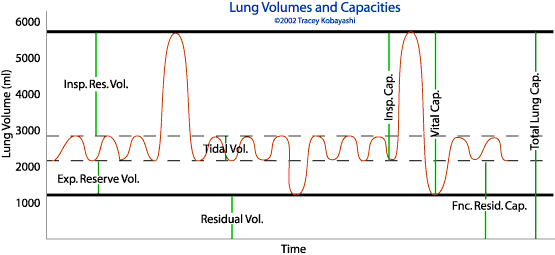
GE 345: Week 3
Pulmonary Volumes & Capacities
Updated by Tracey 23 July 02
| Respiration | Ventilation | Volumes & Capacities | Passageways | Circulation | Regulation |
Through a process called spirometry, air movement in and out of the lungs may be measured. As one breathes, lung volume changes. There are four volumes which do not overlap each-other. Values given are for the average young adult male. Values for females will be 20-25 percent less.
- Tidal Volume (TV or depth of breathing): air volume inspired and expired during each respiratory cycle. Approximately 500 ml in the average young adult male.
- Inspiratory Reserve Volume (IRV): extra volume of air that can be inspired beyond normal tidal volume. Approx. 3000 ml.
- Expiratory Reserve Volume (ERV): extra volume of air that can be expired after a normal tidal expiration. Approx. 1100 ml.
- Residual Volume (RV): volume of air in lungs after a maximal expiration. Approx. 1200 ml.

There are four Pulmonary Capacities, each of which includes two or more of the primary volumes:
- Vital Capacity (VC): maximal volume of gas that can be expelled from the lungs by forceful effort after a maximal inspiration. Approx. 4600 ml, or IRV + TV + ERV
- Total Lung Capacity (TLC): amount of gas in the lungs at the end of a maxiam inspiration. Approx. 5800 ml, or VC + RV
- Inspiratory Capacity (IC): maximum gas volume that can be inspired from the resting expiratory level. Approx 3500 ml, or TV + IRV
- Functional Residual Capacity (FRC): gas volume remaining in the lungs after normal expiration. Approx 2300 ml, or ERV + RV
Normal respiratory rate is about 12 breaths per minute, which means the average adult young male breathes about 1.5 liters of gas in and out of the respiratory passages per minute. This amount is known as the minute respiratory volume.
| Respiration | Ventilation | Volumes & Capacities | Passageways | Circulation | Regulation |